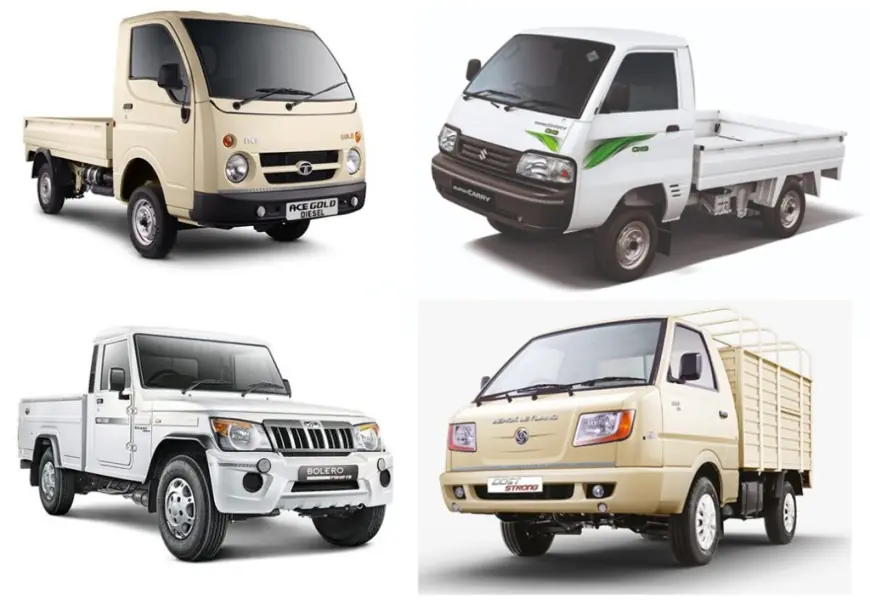India Small Commercial Vehicle Market 2030F
While the market presents significant opportunities, there are several challenges that could impact its growth. A primary barrier is the high upfront cost of electric small commercial vehicles.

Introduction
India’s transportation and logistics landscape is undergoing a remarkable transformation, fueled by rapid urbanization, rising consumer demand, and the growing importance of efficient last-mile connectivity. At the center of this transformation lies the India Small Commercial Vehicle market, a sector that continues to demonstrate resilience and dynamism. According to market estimates, the India Small Commercial Vehicle Market was valued at USD 2.66 billion in 2024 and is projected to reach USD 3.61 billion by 2030, expanding at a CAGR of 5.25% during the forecast period.
The surge in e-commerce, the demand for faster delivery, and the rising focus on fuel-efficient, compact, and cost-effective vehicles have been critical to this growth. SCVs are emerging as indispensable tools not only for logistics players but also for small businesses, farmers, retailers, and enterprises across industries. With the government’s strong push for electric mobility and sustainable transport, this sector is set to expand even further, offering new opportunities and challenges for stakeholders.
Market Drivers
The growth trajectory of the India Small Commercial Vehicle market is shaped by multiple interconnected drivers. These include structural shifts in India’s economy, technological advancements, and changing consumer expectations. Below are the primary drivers:
1. Rapid E-Commerce Expansion
India’s booming e-commerce sector has been the single biggest driver of SCV demand. From groceries to fashion and electronics, the need for last-mile delivery vehicles has skyrocketed. Small commercial vehicles offer maneuverability in congested streets, cost-effectiveness, and the ability to handle frequent, shorter trips.
2. Urbanization and Rising Middle-Class Consumption
India is urbanizing at an unprecedented pace. With cities expanding and a rising middle class demanding faster delivery of goods, the need for flexible and reliable transport solutions has surged. SCVs provide an ideal balance between load capacity and affordability, making them essential for businesses of all sizes.
3. Government Push for Electric Mobility
Government initiatives such as FAME-II (Faster Adoption and Manufacturing of Hybrid and Electric Vehicles) are providing incentives to manufacturers and buyers of electric SCVs. This is reducing upfront costs, making electric small commercial vehicles more attractive for businesses aiming to cut operating expenses and meet sustainability goals.
4. Fuel Efficiency and Cost Optimization
For businesses, operational costs are a decisive factor. SCVs provide significant savings in terms of fuel consumption compared to larger trucks. The growing availability of electric SCVs further reduces fuel dependency, enhancing cost-efficiency in the long run.
5. Growth of Organized Retail and FMCG Distribution
Retail chains, supermarkets, and FMCG companies are increasingly dependent on SCVs for intra-city distribution. The vehicles’ ability to deliver smaller consignments frequently has made them indispensable in ensuring timely product availability.
Download Free Sample Report: https://www.techsciresearch.com/sample-report.aspx?cid=8149
Emerging Trends
The India SCV market is not just growing; it is evolving. Several new trends are reshaping the industry and defining its future:
1. Shift Towards Electric SCVs
The most significant trend is the growing adoption of electric small commercial vehicles. Businesses are drawn by their low maintenance, reduced emissions, and cost-effective operations. Many logistics and delivery companies are experimenting with all-electric fleets for urban operations.
2. Technology Integration and Smart Fleet Management
IoT-enabled SCVs with GPS tracking, telematics, and real-time monitoring are becoming popular. Fleet owners are adopting smart solutions to enhance fuel efficiency, monitor vehicle health, and optimize delivery routes.
3. Compact Vehicle Design for Congested Cities
Manufacturers are innovating with smaller, more agile SCV designs tailored for Indian road conditions. These vehicles can navigate narrow lanes, handle stop-start traffic, and park in limited spaces, making them highly suitable for urban operations.
4. Customization for Diverse Industries
Companies are seeking customized SCVs that meet specific business needs. From refrigerated vans for food delivery to flatbed carriers for construction, tailored solutions are on the rise.
5. Financial Accessibility and Leasing Models
To address high upfront costs, especially in the electric segment, leasing and financing options are gaining traction. This makes SCVs accessible to small businesses, startups, and gig-economy delivery drivers.
Segmentation Insights
The India Small Commercial Vehicle Market can be analyzed based on payload capacity and region.
By Payload Capacity
- Less than 1 Ton
- Dominates last-mile delivery for e-commerce, groceries, and retail.
- High demand due to affordability, maneuverability, and efficiency.
- Plays a vital role in hyper-local logistics.
- 1–2 Tons
- Widely used in urban and semi-urban regions for transporting food, construction materials, and consumer goods.
- Strikes a balance between payload and cost, making it a favorite for small businesses.
- 2–3 Tons
- Caters to heavier transport needs such as construction, mining, agriculture, and regional distribution.
- Popular among medium-sized businesses for bulk movement of goods.
By Region
- Western India (Fastest Growing): States like Maharashtra, Gujarat, and Rajasthan are driving the market due to industrialization, ports, and retail growth.
- Northern India: Delhi NCR, Punjab, and Haryana see robust demand driven by agriculture and e-commerce.
- Southern India: Bengaluru, Chennai, and Hyderabad lead adoption of electric SCVs and tech-driven logistics.
- Eastern India: Emerging demand, with focus on agriculture and rural logistics.
Industry Key Highlights
- India SCV Market to reach USD 3.61 Billion by 2030.
- CAGR of 5.25% between 2024 and 2030.
- Strong demand from e-commerce, FMCG, retail, and agriculture.
- Western region emerging as the fastest-growing market.
- Electric SCVs gaining momentum due to cost and environmental benefits.
- Customization and telematics becoming standard for fleet operations.
Competitive Analysis
The India Small Commercial Vehicle Market is highly competitive, with domestic and international players focusing on innovation, sustainability, and affordability.
Key Market Players
- Tata Motors Limited – Market leader with a wide SCV portfolio including ICE and electric models.
- Mahindra & Mahindra Ltd. – Strong presence with innovative mini-trucks and electric offerings.
- Ashok Leyland Limited – Focuses on urban logistics and electric mobility.
- Piaggio Vehicles Pvt. Ltd. (PVPL) – Popular for three-wheeler SCVs catering to small businesses.
- Bajaj Auto Ltd. & TVS Motor Company – Major players in three-wheelers for urban transport.
- Isuzu Motors India – Offers robust SCVs for medium payload applications.
- Emerging EV Startups (Saera Electric Auto, Lohia Auto Industries) – Driving adoption of sustainable mobility.
Competition is intensifying as companies integrate EV technology, digital solutions, and financing options to attract buyers.
Future Outlook
The India Small Commercial Vehicle Market is poised for sustainable growth, supported by economic development, rising urbanization, and the demand for cleaner transport.
- Electric SCVs will lead the next phase of growth, driven by government incentives and business cost savings.
- Smart logistics powered by IoT and AI will transform fleet management.
- Rural penetration of SCVs will expand as infrastructure improves, boosting agriculture and small-scale industries.
- Collaborations between manufacturers, fleet operators, and tech firms will create new business models.
- Export opportunities may rise as India becomes a hub for compact commercial vehicle production.
By 2030, India’s SCV market will not only support logistics efficiency but also contribute significantly to the nation’s sustainability goals.
10 Benefits of the Research Report
- Provides accurate market size and growth forecast for informed decision-making.
- Offers in-depth segmentation insights by payload capacity, propulsion, and region.
- Identifies key growth drivers shaping the industry.
- Analyzes emerging trends such as electric SCVs and fleet digitalization.
- Examines regional dynamics and market opportunities.
- Delivers competitive landscape analysis with profiling of major players.
- Highlights government policies and their impact on SCV adoption.
- Assists businesses in investment planning and strategic expansion.
- Provides insights into consumer behavior and industry applications.
- Acts as a reliable guide for stakeholders, including manufacturers, investors, and policymakers.
Conclusion
The India Small Commercial Vehicle Market is undergoing a structural transformation, becoming a critical enabler of India’s economic growth. From powering the e-commerce revolution to enabling sustainable transport through electric SCVs, the market is poised for an exciting decade ahead. While challenges such as fluctuating fuel costs and initial EV investment barriers remain, the opportunities far outweigh the hurdles.
With robust government support, innovation by manufacturers, and rising demand for cost-effective transport solutions, the SCV sector is set to grow into a multi-billion-dollar industry by 2030. Businesses that adapt to changing consumer preferences, embrace sustainability, and integrate technology will be at the forefront of this evolution.
Contact Us-
Mr. Ken Mathews
708 Third Avenue,
Manhattan, NY,
New York – 10017
Tel: +1-646-360-1656
Email: [email protected]
Website: www.techsciresearch.com
What's Your Reaction?
 Like
0
Like
0
 Dislike
0
Dislike
0
 Love
0
Love
0
 Funny
0
Funny
0
 Angry
0
Angry
0
 Sad
0
Sad
0
 Wow
0
Wow
0


















































